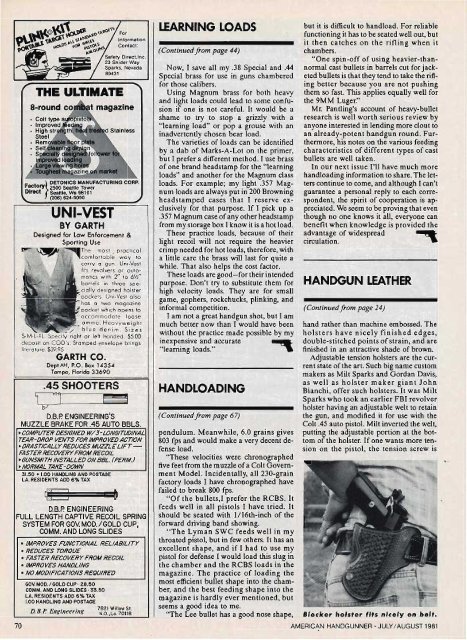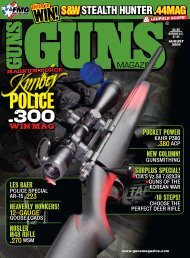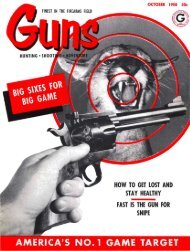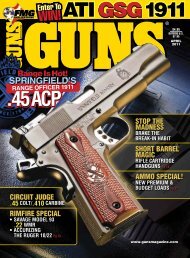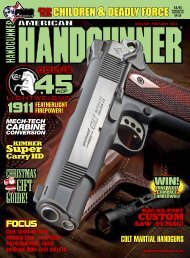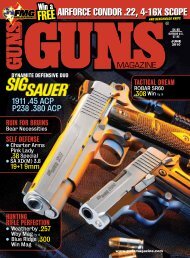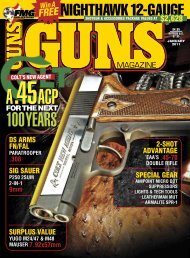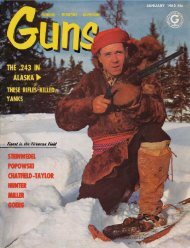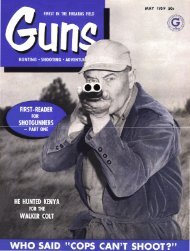American Handgunner Jul/Aug 1981 - Jeffersonian
American Handgunner Jul/Aug 1981 - Jeffersonian
American Handgunner Jul/Aug 1981 - Jeffersonian
You also want an ePaper? Increase the reach of your titles
YUMPU automatically turns print PDFs into web optimized ePapers that Google loves.
-NORMAL TAKE-DOWN<br />
31.50 + 1.00 HANDLING AND POSTAGE<br />
LA. RESIDENTS ADD 6% TAX<br />
70<br />
F t }DETONICS MANUFACTURING CORP.<br />
8C. ory 2500 Seattle Tower<br />
0 reel Seattle. Wa 98101<br />
(206) 624-9090<br />
UNI-VEST<br />
BY GARTH<br />
Designed for Law Enforcement &<br />
Sporting Use<br />
~The most practical<br />
l:~t, .... comlortobl~ way to<br />
corry a gun. Uni-Vest<br />
fits revolvers or automatics<br />
with '2" to 6y,"<br />
barrels in three specially<br />
designed holster<br />
: pockets. Uni-Vest also<br />
- has a two magazine<br />
- pocket which opens to<br />
accommodate loose<br />
, ommo ..Heovyweight<br />
..:t'/ blue denim. Sizes<br />
S-M-l-Xl. Specify right or left handed. $5.00<br />
deposit on COD·s. Stomped envelope brings<br />
literature. $39.95<br />
GARTH CO.<br />
DeptAH, P.o. Box 14354<br />
Tampa, Florida 33690<br />
o<br />
.45 SHOOTERS<br />
~<br />
D.B.P. ENGINEERING'S<br />
MUZZLE BRAKE FOR .45 AUTO BBLS.<br />
-COMPUTER DESIGNED W/3-LONGITUDINAL<br />
TEAR-DROP VENTS FOR IMPROVED ACTION<br />
- DRASTICALLY REDUCES MUZZLELlFT<br />
FASTERRECOVERYFROMRECOIL<br />
-GUNSMITHINSTALLED ONBBL. (PERM)<br />
D.B.P. ENGINEERING<br />
FULL LENGTH CAPTIVE RECOI L SPRING<br />
SYSTEM FOR GOY. MOD. IGOLD CUP,<br />
COMM. AND LONG SLIDES<br />
• IMPROVES FUNCTIONAL RELIABILITY<br />
• REDUCES TORQUE<br />
• FASTER RECOVERY FROM RECOIL<br />
• IMPROVES HANDLING<br />
• NO MODIFICATIONS REQUIRED<br />
GOV.MOD.lGOLD cup· 28.50<br />
COMM. AND LONG SLIDES· 33.50<br />
LA. RESIDENTS ADD 6% TAX<br />
1.00 HANDLING AND POSTAGE<br />
D.D.P. Engineering<br />
7~~1 t~II~~l~~<br />
LEARNING LOADS<br />
(Continued from page 44)<br />
Now, I save all my .38 Special and .44<br />
Special brass for use in guns chambered<br />
for those calibers.<br />
Using Magnum brass for both heavy<br />
and light loads could lead to some confusion<br />
if one is not careful. It would be a<br />
shame to try to stop a grizzly with a<br />
"learning load" or pop a grouse with an<br />
inadvertently chosen bear load.<br />
The varieties of loads can be identified<br />
by a dab of Marks-A-Lot on the primer,<br />
but I prefer a different method. I use brass<br />
of one brand headstamp for the "learning<br />
loads" and another for the Magnum class<br />
loads. For example; my light .357 Magnum<br />
loads are always put in 200 Browning<br />
headstamped cases that I reserve exclusively<br />
for that purpose. If I pick up a<br />
.357 Magnum case ofany other headstamp<br />
from my storage box I know it is a hot load..<br />
These practice loads, because of their<br />
light recoil will not require the heavier<br />
crimp needed for hot loads, therefore, with<br />
a little care the brass will last for quite a<br />
while. That also helps the cost factor.<br />
These loads are good-for their intended<br />
purpose. Don't try to substitute them for<br />
high velocity loads. They are for small<br />
game, gophers, rockchucks, plinking, and<br />
informal competition.<br />
I am not a great handgun shot, but I am<br />
much better now than I would have been<br />
without the practice made possible by my<br />
inexpensive and accurate ......<br />
"learning loads." ~<br />
HANDLOADING<br />
(Continued from page 67)<br />
pendulum. Meanwhile, 6.0 grains gives<br />
803 fps and would make a very decent defense<br />
load.<br />
"These velocities were chronographed<br />
five feet from the muzzle ofa Colt Government<br />
Model. Incidentally, all 230-grain<br />
factory loads I have chronographed have<br />
failed to break 800 fps.<br />
"Of the bullets,1 prefer the RCBS. It<br />
feeds well in all pistols I have tried. It<br />
should be seated with 1!l6th-inch of the<br />
forward driving band showing.<br />
"The Lyman SWC feeds well in my<br />
throated pistol, but in few others. It has an<br />
excellent shape, and if I had to use my<br />
pistol for defense I would load this slug in<br />
the chamber and the RCBS loads in the<br />
magazine. The practice of loading the<br />
most efficient bullet shape into the chamber,<br />
and the best feeding shape into the<br />
magazine is hardly ever mentioned, but<br />
seems a good idea to me.<br />
"The Lee bullet has a good nose shape,<br />
but it is difficult to handload. For reliable<br />
functioning it has to be seated well out, but<br />
it then catches on the rifling when it<br />
chambers.<br />
"One spin-off of using heavier-thannormal<br />
cast bullets in barrels cut for jacketed<br />
bullets is that they tend to take the rifling<br />
better because you are not pushi,ng<br />
them so fast. This applies equally well for<br />
the 9MM Luger?'<br />
Mr. Pantting's account of heavy-bullet<br />
research is well worth serious review by<br />
anyone interested in lending more clout to<br />
an already-potent handgun round. Furthermore,<br />
his notes on the various feeding<br />
characteristics of different types of cast<br />
bullets are well taken.<br />
In our next issue I'll have much more<br />
handloading information to share. The letters<br />
continue to come, and although I can't<br />
guarantee a personal reply to each correspondent,<br />
the spirit of cooperation is appreciated.<br />
We seem to be proving that even<br />
though no one knows it all, everyone can<br />
benefit when knowledge is provided the<br />
advantage of widespread ...<br />
circulation. ~<br />
HANDGUN LEATHER<br />
(Continued from page 24)<br />
hand rather than machine embossed. The<br />
holsters have nicely finished edges,<br />
double-stitched points ofstrain, and are<br />
finished in an attractive shade of brown.<br />
Adjustable tension holsters are the current<br />
state ofthe art. Such big name custom<br />
makers as Milt Sparks and Gordan Davis,<br />
as well as holster maker giant John<br />
Bianchi, offer such holsters. It was Milt<br />
Sparks who took an earlier FBI revolver<br />
holster having an adjustable welt to retain<br />
the gun, and modified it for use with the<br />
Colt .45 auto pistol. Milt inverted the welt,<br />
putting the adjustable portion at the bottom<br />
of the holster. If one wants more tension<br />
on the 'pistol, the tension screw is<br />
Blocker holster fits nicely on belt.<br />
AMERICAN HANDGUNNER • JULY / AUGUST <strong>1981</strong>


